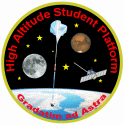



Payload 01 Information
Payload Flight Number:
Institution:
Payload Title:
Flight Test of a GRID on the High Altitude X-Ray/Gamma-Ray Detector Testbed (HAXDT)
Student Leader:
Faculty Advisor:
Payload class:
SMALL
Payload ID Number:
01
Mass:
2.9kg
Current:
222mA
Serial Downlink:
YES
Analog Downlink:
NO
Serial Commands:
YES
Discrete Commands:
NO
Payload Specification & Integration Plan
Due:
Delivered:
Payload Integration Certification
Scheduled:
Actual:
Flight Operation Plan
Due:
Delivered:
Final Flight / Science Report
Due:
Delivered:
Abstract:
The High Altitude X-Ray/Gamma-Ray Detector Testbed (HAXDT) is platform used for flight testing prototype sensors and sensing concepts for CubeSats. HAXDT has a 3 U CubeSat form factor and is designed to interface with High Altitude Student Payload (HASP) adapter plate. It hosts a flight computer and which is used to log data from the prototype sensor. The logged data is saved to solid state hard drive that is analyzed after flight to assess the performance of the prototype sensor. On the 2016 HASP flight, HAXDT will host the 3rd generation prototype of the Gamma Ray Incidence Detector (GRID) developed at the University of Minnesota. GRID is essentially a gamma-ray (and hard x-ray) detector optimized for making accurate positioning, navigation and timing (PNT) measurements. In operation, it will use signals of opportunity (e.g., naturally occurring gamma-ray emissions for sources such as Gamma-Ray Bursts or GRBs) as navigation and timing beacons akin to GPS satellites. Currently, GRID is at a Technology Readiness Level (TRL) of 5. The HASP 2016 flight test is “stepping stone” in preparation for an eventual CubeSat flight whose goal is to elevate the TRL to 7. |